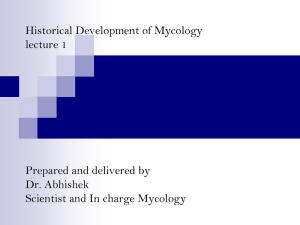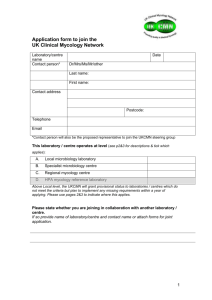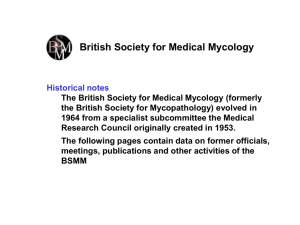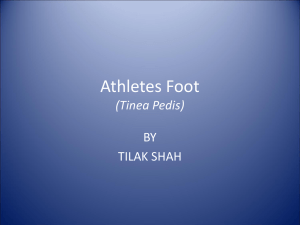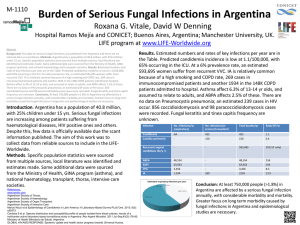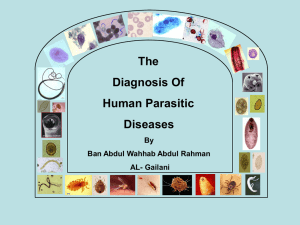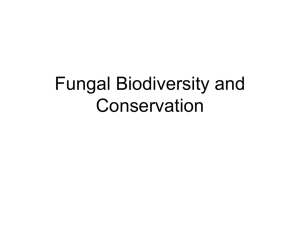Example #2 Diagnostic Microbiology UO
advertisement
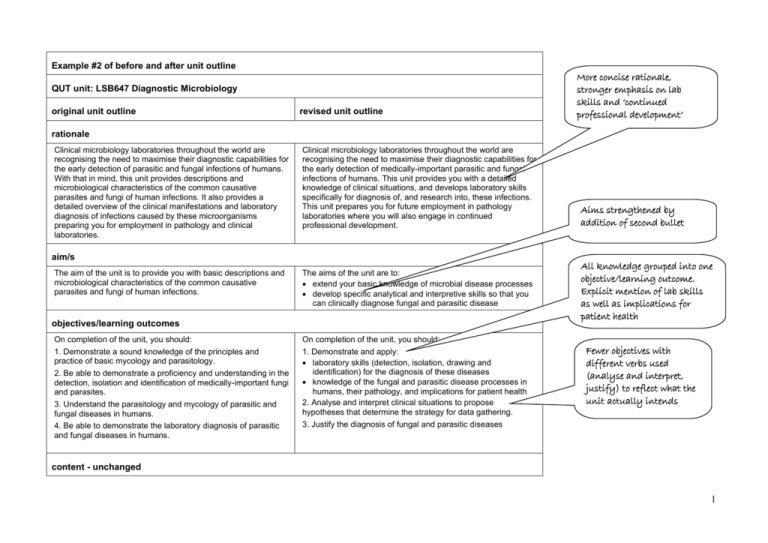
Example #2 of before and after unit outline QUT unit: LSB647 Diagnostic Microbiology original unit outline revised unit outline rationale Clinical microbiology laboratories throughout the world are recognising the need to maximise their diagnostic capabilities for the early detection of parasitic and fungal infections of humans. With that in mind, this unit provides descriptions and microbiological characteristics of the common causative parasites and fungi of human infections. It also provides a detailed overview of the clinical manifestations and laboratory diagnosis of infections caused by these microorganisms preparing you for employment in pathology and clinical laboratories. Clinical microbiology laboratories throughout the world are recognising the need to maximise their diagnostic capabilities for the early detection of medically-important parasitic and fungal infections of humans. This unit provides you with a detailed knowledge of clinical situations, and develops laboratory skills specifically for diagnosis of, and research into, these infections. This unit prepares you for future employment in pathology laboratories where you will also engage in continued professional development. aim/s The aim of the unit is to provide you with basic descriptions and microbiological characteristics of the common causative parasites and fungi of human infections. The aims of the unit are to: extend your basic knowledge of microbial disease processes develop specific analytical and interpretive skills so that you can clinically diagnose fungal and parasitic disease objectives/learning outcomes On completion of the unit, you should: 1. Demonstrate a sound knowledge of the principles and practice of basic mycology and parasitology. 2. Be able to demonstrate a proficiency and understanding in the detection, isolation and identification of medically-important fungi and parasites. 3. Understand the parasitology and mycology of parasitic and fungal diseases in humans. 4. Be able to demonstrate the laboratory diagnosis of parasitic and fungal diseases in humans. On completion of the unit, you should: 1. Demonstrate and apply: laboratory skills (detection, isolation, drawing and identification) for the diagnosis of these diseases knowledge of the fungal and parasitic disease processes in humans, their pathology, and implications for patient health 2. Analyse and interpret clinical situations to propose hypotheses that determine the strategy for data gathering. 3. Justify the diagnosis of fungal and parasitic diseases More concise rationale, stronger emphasis on lab skills and ‘continued professional development’ changed Aims strengthened by addition of second bullet All knowledge grouped into one objective/learning outcome. Explicit mention of lab skills as well as implications for patient health Fewer objectives with different verbs used (analyse and interpret, justify) to reflect what the unit actually intends content - unchanged 1 Third year QUT unit, LSB647 DIAGNOSTIC MICROBIOLOGY original unit revised unit Approaches to teaching and learning The unit consists of parasitology and mycology (50% each). Material is presented in 2 hours of lectures, a 2 hour laboratory session and a 1 hour student self-directed tutorial session per week. You are encouraged to support your knowledge by the use of the library facilities in particular, use of videos and interactive computer software programs covering the course content. The parasitology component has a computer-based parasitology database which you will use weekly in self-directed tutorials to complete the weekly tutorial sheets. The theoretical section of the mycology component of the unit is substantiated with use of Kaminski's teaching slides on medical mycology. A computer software program entitled "A Fungal Atlas" is used in mycology practical classes. Three approaches to teaching and learning are used in this unit to scaffold your learning by closely integrating theory and practice. (i) fostering of independent learning to assist your transition to clinical or research workplaces by: developing your information literacy skills by locating, accessing, evaluating and using sources such as journals, books, websites, interactive computer software programs, online quizzes providing weekly self-directed tutorials. (ii) developing your practical skills in an authentic laboratory context that mirrors real life practices, including actual clinical case studies explored under the guidance of professionals from clinical practice (iii) modelling of professional practice by using past students as peer mentors to assist you in developing your diagnostic skills. Mycology Online (http://sciweb.science.adelaide.edu.au/mycology/myco.nsf) is used as a reference tool and for self-directed tutorial sessions for you in the unit. Mycology Online (http://sciweb.science.adelaide.edu.au/mycology/myco.nsf) is used as a reference tool and for self-directed tutorial sessions for you in the unit Contact times (Weekly): 2 hours (lectures), 2 hours (practical session), 1 hour (tutorial) Contact times (Weekly): 2 hours (lectures), 2 hours (practical session), 1 hour (tutorial) Teaching approaches specified instead of just focussing on delivery modes. The 3 approaches together show intention to prepare students for the workplace 2 Assessment Formative feedback will be provided by the completion and marking of weekly laboratory report sheets and the selfdirected tutorials. Formative feedback on your weekly laboratory report sheets and the self-directed tutorials prepares you for your practical exam. To assist you with preparing your responses to assessment tasks, you will be given examples of what is expected so that you can develop your understanding of how to use criteria sheets. 1. Type: Examination Description: Parasitology/Mycology: Practical; summative Relates to Objectives 1 and 3 Due Date: End of semester Weight: 20% 1. Type: examination -practical Description: Parasitology/Mycology: summative Relates to Objectives 1, 2 and 3 Due Date: end of semester Weight: 20% 2. Type: Assignment Description: Mycology: 5000-6000 word assignment; summative Relates to Objectives 1 and 2 Due Date: Mid-semester Weight: 40% 3. Type: Examination Description: Parasitology: End-semester. Theory: 40%, Practical: 10%. Short answer and essay-type questions Relates to Objectives 1, 2, 3 and 4 Due Date: End of semester Weight: 40% 2. Type: assignment (independent) Description: Format described in week 1 document; summative Relates to Objectives 1, 2 and 3 Due Date: week 10 of semester Weight: 40% Explicit mention of criteria sheets and examples of standard of work 3. Type: examination –written theory Description: end-semester. Theory: 40%. Short answers. Relates to Objectives 1, 2, 3 Due Date: end of semester Weight: 40% 3
